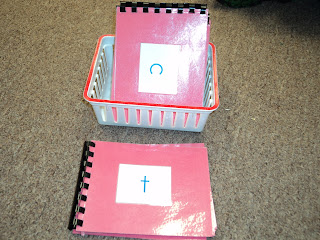I use the Three Period Lesson to introduce letter sounds to my students:
1. I show them the sand paper letter and say the sound (not the letter name). I then trace the letter and say the sound.
2. I have them trace the letter and say the sound
3. I have them tell me what the letter sound is.
If they can tell me the letter sound I write the letter in their sound book. If they have trouble remembering what the letter is we do the three period lesson again.
When we meet to do sounds again we will review the letters in their sound books. If they don't remember a letter sound then I fold the corner of the page and we will review the sound with the sand paper letters. If they know all the sounds in their books then we will add a new letter.
This is the order that I introduce the letters: a, s, m, e, t, c, o, p, u, d, f, j, g, l, b, i, n, w, r, h, y, q, z, k, v, x.
Here is a link to google docs for a template for the sound book covers:
Sound Book Covers
To help the students hear the letter sounds in words I made these letter sound books. In each book there are pictures of objects that begin with those letters. I grouped 6-7 letters together and color coded them so they would be easier to organize. The first six letters a, s, m, e, t, and c are red and are stored in the red basket. I couldn't find different color baskets like what I wanted so I used white plastic baskets and used a Sharpie to color the edge. The students then can place them into the correct basket when they are done.
When saying the name of the object on the page I say the beginning sound 2 times and then say the name that way they can hear the beginning sound clearly. Example: /t/, /t/, turtle
This is how the books are stored on the language arts shelf.
The baskets in front of the books have sound sorting cards.




































